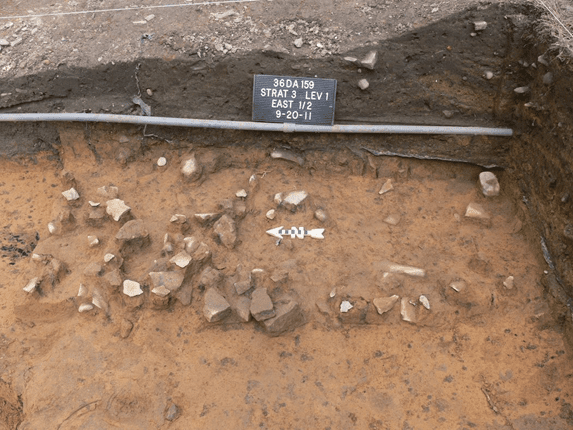
It’s that time of year again when we pull out our favorite cozy sweaters, eat and drink a lot of pumpkin spice, and snuggle up in front of the fireplace; autumn is here. Just as we do now, people throughout time have used fires to warm themselves and their homes. Evidence of this human behavior is found in both Precontact and historic archaeological sites. On Precontact sites archaeologists find dark stains in the soil filled with charcoal and fire cracked rock remains in the ground. These stains, called features, are the remains of the cooking and heating fires left by Precontact peoples. On historic sites the artifacts that indicate the use of fire tend to be more substantial, including the remnants of the cast-iron wood-burning stoves, which have been a popular form of heating since the mid-1600’s (Britannica, The Editors of Encyclopaedia 2021).
 |
| Image of hearth feature exposing fire cracked rock and charcoal at Ft Hunter (36DA0159), note the charcoal deposit inside red circle. Image from the collection of the State Museum of Pennsylvania. |
Cast iron stoves were made from pouring molten cast iron into molds to make plates, which were then bolted together to form a box. In 1642, the first cast iron stove was produced in America, in Lynn Massachusetts (Britannica, The Editors of Encyclopaedia 2021). These stoves were improved upon over time. By the 1740’s, multi-plated stoves were in production, six plate stoves were the beginning of developing a more efficient stove design. In 1744, Benjamin Franklin created the “Pennsylvania stove”, also known as the Franklin stove, a more efficient stove than the earlier forms. This stove allowed for more heat production in the home with less heat escaping with the smoke (Britannica, The Editors of Encyclopaedia 2021; Harris, 2013). Following the Pennsylvania stove, the ten-plate stove was yet again more efficient and could burn both wood and coal (Harris 213). Stove plates were often highly decorated and provided information about the furnace where they were produced. Often, when stove remnants are found on an archaeological site it is the fragments of one of the plates, and with luck some of the decorations or text cast into the piece remain. One such stove plate can be found in The State Museum of Pennsylvania, Section of Archaeology’s collections.
 |
| Ten-plate cast iron stoves. Image from the collections of the Hopewell Furnace. |
 |
| Stove plate fragments found at the Thompson Neely Sawmill site, 36Bu18. Image from the collection of The State Museum of Pennsylvania. |
 |
| Earlier Colebrookdale Furnace stove plate with furnace name and Thomas Rutter on the plate. Image from the collection of The State Museum of Pennsylvania, Community & Domestic Life. |
Together the Rutter and Potts families owned several furnace and forge facilities including Colebrookdale Furnace and Forge, Mount Pleasant Furnace and Forge, as well as Spring, Amity, Rutter’s, Pool, Pine, Little Pine and McCall’s Forges. Rutter died in March of 1730 making Potts the principal owner and manager of these businesses. Between 1729 through the mid-1760s Colebrookdale Furnace provided the pig iron to several other furnaces in the area and was a very active furnace from its start until the beginning of the American Revolution. Account ledgers for the furnace recorded the years of production and the number of pots and kettles produced there with many of the vessels going to the Quaker community in Berks County. The historic mill property from which this artifact was recovered served the surrounding communities and Philadelphia merchants. This trade allowed for the growth and expansion of the Thompson Neely House and family. Historic records indicate that William Neely had married Robert Thompson’s daughter in 1766 and was likely the proprietor at the time the stove plate was created.
Thomas Potts died in 1752, leaving the Colebrookdale Furnace to his son Thomas Potts Jr. Eventually the furnace was no longer in use or in the Potts family as none of Thomas Potts Jr.’s children wanted it (Gemmell 1949; The Committee for Historical Research 1914). The Colebrookdale furnace was a highly successful iron furnace while in operation, especially during the time it was managed by the Potts and Rutter families. As the first blast furnace in Pennsylvania the, Colebrookdale Furnace made a significant contribution to the spread of the iron industry in central and eastern Pennsylvania. By 1775, the southeastern region of Pennsylvania contained the highest concentration of forges and furnaces in the country, contributing to our nation’s ability to gain independence from Britain since we were no longer dependent on English supply.
References:
Britannica, The Editors of Encyclopedia
2021 stove. Electronic Document. https://www.britannica.com/technology/stove. Accessed September 9, 2022.
Gemmell, Alfred
1949 The Charcoal Iron Industry in the Perkiomen Valley. Hartenstine Printing House, Norristown, Pennsylvania.
Harris, Howell
2013 A Collection of Stoves from American Museums, I: Plate Stoves. A Stove Less Ordinary (blog). October 22. http://stovehistory.blogspot.com/2013/10/a-collection-of-stoves-metropolitan.html. Accessed September 9, 2022.
National Park Service
2020 Cast Iron Stove Production at Hopewell Furnace. Electronic
Document. https://www.nps.gov/hofu/learn/historyculture/cast-iron-stove-production.htm.
Accessed September 9, 2022.
Pennsylvania Historical and Museum
Commission
2019 Colebrookdale Furnace Historical Marker. Electronic Document. https://explorepahistory.com/hmarker.php?markerId=1-A-2A3.
Accessed September 9, 2022.
The Committee on Historical Research
1914 Forges and Furnaces in the Province of Pennsylvania, Prepared by the Committee on Historical Research. Prepared for The Pennsylvania Society of the Colonial Dames of America. Philadelphia, Pa.
For more information, visit PAarchaeology.state.pa.us or the Hall of Anthropology and Archaeology at The State Museum of Pennsylvania .






